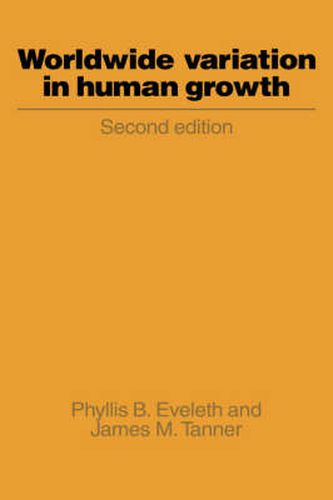Readings Newsletter
Become a Readings Member to make your shopping experience even easier.
Sign in or sign up for free!
You’re not far away from qualifying for FREE standard shipping within Australia
You’ve qualified for FREE standard shipping within Australia
The cart is loading…






The health of a population is most accurately reflected in the rate of growth of its children. It is this theme which underlies the analysis and presentation of what is by far the largest compilation of growth data ever assembled. The first edition, published in 1976, included all known reliable recent results on height, weight, skinfolds and other body measurements from all parts of the globe. In this edition, the very numerous measurements taken between 1976 and 1988 have been included as well as the results of the large number of new studies made on rate of maturation as evinced by bone age and pubertal development stages. Many sections of the book dwell on disentangling the effects of the environment and heredity on growth, and thus answer the question of whether one universal standard suffices for all peoples of the world, or whether different populations (such as races or nations) should each have their own optimal growth standards. Written by practical people with experience of the problems in developing countries, this book explains in simple terms the different sorts of growth surveys, how to set about making them, and which sort to choose. All who are professionally concerned with child health should read it.
$9.00 standard shipping within Australia
FREE standard shipping within Australia for orders over $100.00
Express & International shipping calculated at checkout
The health of a population is most accurately reflected in the rate of growth of its children. It is this theme which underlies the analysis and presentation of what is by far the largest compilation of growth data ever assembled. The first edition, published in 1976, included all known reliable recent results on height, weight, skinfolds and other body measurements from all parts of the globe. In this edition, the very numerous measurements taken between 1976 and 1988 have been included as well as the results of the large number of new studies made on rate of maturation as evinced by bone age and pubertal development stages. Many sections of the book dwell on disentangling the effects of the environment and heredity on growth, and thus answer the question of whether one universal standard suffices for all peoples of the world, or whether different populations (such as races or nations) should each have their own optimal growth standards. Written by practical people with experience of the problems in developing countries, this book explains in simple terms the different sorts of growth surveys, how to set about making them, and which sort to choose. All who are professionally concerned with child health should read it.